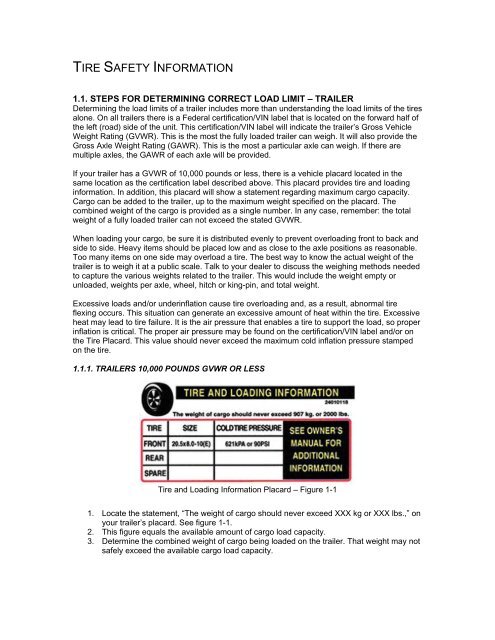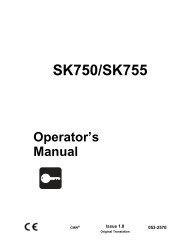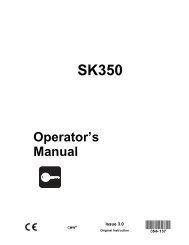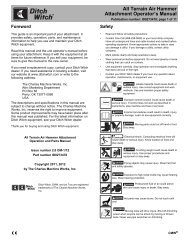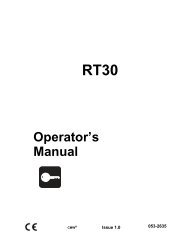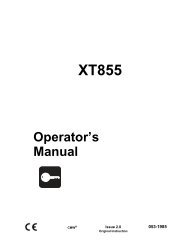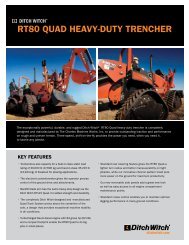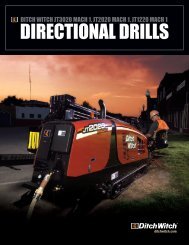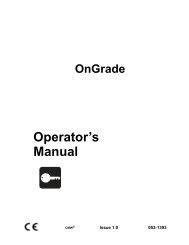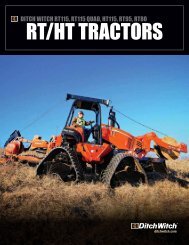FX25 Operator's Manual - Ditch Witch
FX25 Operator's Manual - Ditch Witch
FX25 Operator's Manual - Ditch Witch
Create successful ePaper yourself
Turn your PDF publications into a flip-book with our unique Google optimized e-Paper software.
TIRE SAFETY INFORMATION<br />
1.1. STEPS FOR DETERMINING CORRECT LOAD LIMIT – TRAILER<br />
Determining the load limits of a trailer includes more than understanding the load limits of the tires<br />
alone. On all trailers there is a Federal certification/VIN label that is located on the forward half of<br />
the left (road) side of the unit. This certification/VIN label will indicate the trailer’s Gross Vehicle<br />
Weight Rating (GVWR). This is the most the fully loaded trailer can weigh. It will also provide the<br />
Gross Axle Weight Rating (GAWR). This is the most a particular axle can weigh. If there are<br />
multiple axles, the GAWR of each axle will be provided.<br />
If your trailer has a GVWR of 10,000 pounds or less, there is a vehicle placard located in the<br />
same location as the certification label described above. This placard provides tire and loading<br />
information. In addition, this placard will show a statement regarding maximum cargo capacity.<br />
Cargo can be added to the trailer, up to the maximum weight specified on the placard. The<br />
combined weight of the cargo is provided as a single number. In any case, remember: the total<br />
weight of a fully loaded trailer can not exceed the stated GVWR.<br />
When loading your cargo, be sure it is distributed evenly to prevent overloading front to back and<br />
side to side. Heavy items should be placed low and as close to the axle positions as reasonable.<br />
Too many items on one side may overload a tire. The best way to know the actual weight of the<br />
trailer is to weigh it at a public scale. Talk to your dealer to discuss the weighing methods needed<br />
to capture the various weights related to the trailer. This would include the weight empty or<br />
unloaded, weights per axle, wheel, hitch or king-pin, and total weight.<br />
Excessive loads and/or underinflation cause tire overloading and, as a result, abnormal tire<br />
flexing occurs. This situation can generate an excessive amount of heat within the tire. Excessive<br />
heat may lead to tire failure. It is the air pressure that enables a tire to support the load, so proper<br />
inflation is critical. The proper air pressure may be found on the certification/VIN label and/or on<br />
the Tire Placard. This value should never exceed the maximum cold inflation pressure stamped<br />
on the tire.<br />
1.1.1. TRAILERS 10,000 POUNDS GVWR OR LESS<br />
Tire and Loading Information Placard – Figure 1-1<br />
1. Locate the statement, “The weight of cargo should never exceed XXX kg or XXX lbs.,” on<br />
your trailer’s placard. See figure 1-1.<br />
2. This figure equals the available amount of cargo load capacity.<br />
3. Determine the combined weight of cargo being loaded on the trailer. That weight may not<br />
safely exceed the available cargo load capacity.


